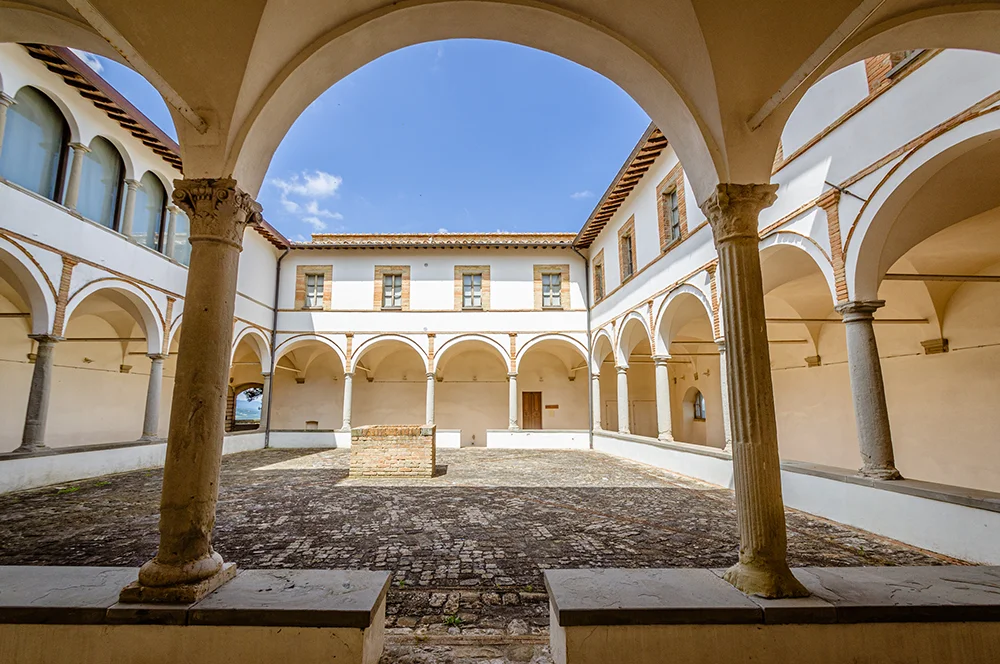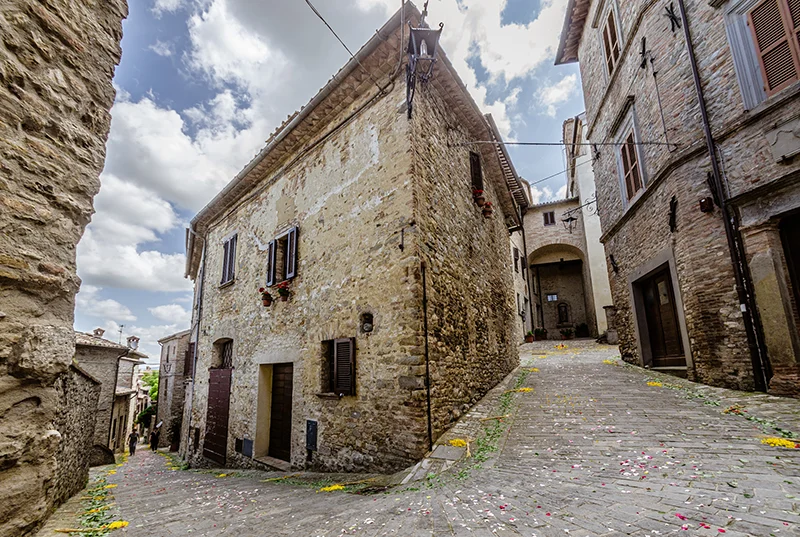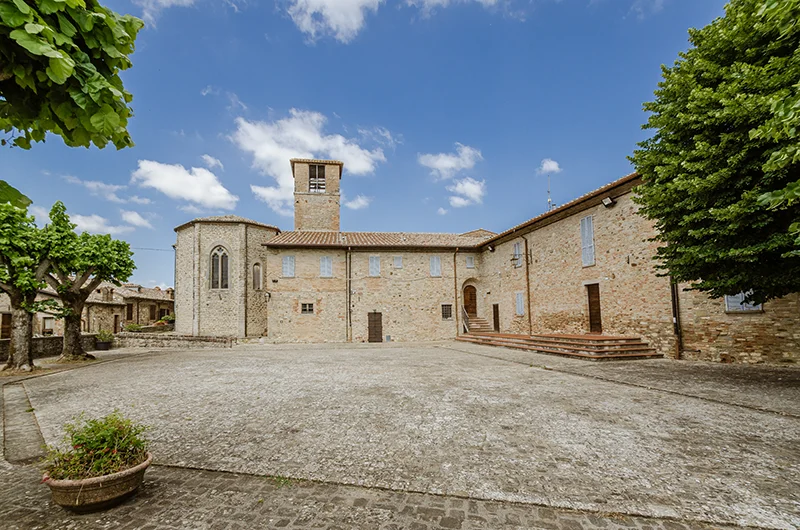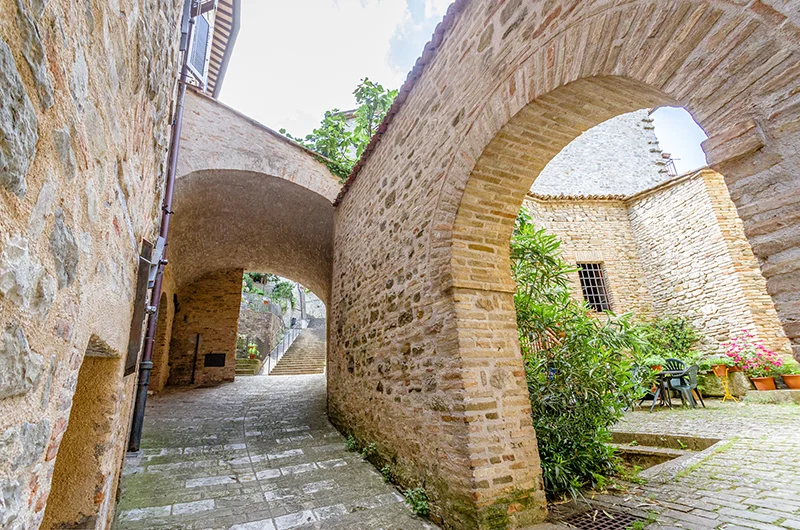If you have never experienced walking around a medieval town, you should definitely check out Montone, where you can absolutely breathe the Middle Age in the air, especially during the Donation of the Holy Thorn festival in August.
Montone sits on a hilltop from which you can contemplate the valley of the river Tiber on one side, and the hills of the Apennines on the other. Walking around this small town is really peaceful and most likely there will be an unnatural silence if you come from some busy city. This peace is broken with the sound of medieval drums and horns if you come across this town on the third week of August.
Where is Montone
Montone is located in the Upper Tiber Valley in Umbria, Italy, and is near to Umbertide and Città di Castello. It is easily reachable with a car drive from these two towns and from Perugia, as it is really close to the E45 freeway that passes through the valley below. It takes about 10 minutes from Umbertide, 20 from Città di Castello and 35 from Perugia.

If you want to visit Montone form somewhere else in Umbria it is as easy as to take the E45 freeway following the directions for Cesena, if you are in the south of Umbria, or following the directions for Rome if you happen to be in the Città di Castello area. From Montone you could also get to the town of Pietralunga.
A bit of history of the Fortebracci family
For what we know the history of Montone begins in the X century during the dominion of the Bourbon Marquis of Monte Santa Maria Tiberina, but its fame started to rise during the XII century when the Fortebracci family submitted Montone to Perugia making the history of this town strongly tied to this family and its ups and downs.
The most brith moment for the town was under Braccio Fortebraccio from Montone which became a famous captain of fortune during the beginning of the XV century. Braccio, whose real name was Andrea, was a controversial and charismatic swordsman who learned the art of fighting from a young age. His story is full of battles, intrigues and alliances with the most influential people of his age in central Italy: from the Montefeltro and Malatesta families to the Pope Bonifacio IX. He gained most of his fame and wealth from the multitude of raids he carried out against his enemies, during which he developed an unique military strategy and was able to put together a mid size army.
Among the many battles he fought the turn point was the battle of Perugia which took place in S. Egidio, near Perugia where nowday is placed the airport of Umbria. Won the battle with his military strength he soon became the lord of Perugia and during his domination he increased the fortification of the city. Recently, to remember how much this events where important for the city, a medieval festival named Perugia1416 takes place in Perugia. If you will have the chance to visit Sala dei Notari in Perugia you will see a big fresco, above all others, depicting the heraldic emblem of the Fortebraccio family: an aries, symbol of Montone, with a silver helmet surmounted by a leopard, symbol of the Fortebraccio family.
Braccio and his ambition didn’t stop there and soon he conquered many other towns in Umbria including Todi, Narni, Orvieto and Terni, making him one of the most influential lords in Umbria during this period. This rapid expansion to the south and his alliance with the Angioini of Naples made Pope Martino V nervous about Braccio, to the point that he excommunicated him.
In 1424 Braccio died after being wounded in a battle in L’Aquila. His dream to create an independent state in central Italy, with Perugia as its capital, failed and wasn’t buried in a sacred place until 1432 when his nephew Niccolò decided it was the time for his bones to rest in the church of San Francesco al Prato in Perugia.
After the death of Braccio Montone returned under the direct control of the Church. His son Carlo took over and followed his father’s footsteps. In 1473 after fighting in service of the Republic of Venice (”La Serenissima”) against the Turks, as a compensation for his bravery, he was gifted a thorn from the crown of Jesus Christ, which happened to be in venetian hands before passing to the French’s. Carlo sends the precious thorn relic to Montone and decrees that it should be celebrated on Easter Monday.
The thorn attracted so many devoted people that was decreed there should be another celebration on the third week of August. This tradition still continues today with the Donation of the Holy Thorn festival and has become one of the main things for which the people in Montone are proud of. Montone was administered by the Vitelli family of the near Città di Castello until 1604 on the behalf of the Church.
What to visit in Montone
Montone is a small town so if you stop by for a quick visit it wouldn’t take too much time to have a walk around and feel the vibe of the place, or take some pictures. You can take the chance to visit Montone and have a nice meal in one of the good restaurants there, where you can taste many local products like cold cuts, cheeses, fresh truffle or handmade pasta.
Nice spots to visit inside the town are the ruins of the Rocca di Braccio, the ancient castle of Braccio Fortebraccio destroyed in 1478 by Pope Sisto IV, and Museo di San Francesco (S. Francis’ Museum). From both two spots you can enjoy a wonderful view of the landscape and the valley below. If you don’t mind climbing a few steps you can also visit the ancient bell tower, whose entrance is just right in the main Piazza of the town.

If you instead are going to spend a little more time in the area maybe you should not miss the Donation of the Holy Thorn and the Umbria Film Festival events, or have an outdoor walk to Rocca d’Aries, if you enjoy hiking.
The Donation of the Holy Thorn festival
During the third week of August the three districts of the town, Porta del Borgo, Porta del Monte and Porta del Verziere compete for an entire week, launching challenges to each other, representing scenes of medieval life and trying their hand at archery, in order to win the Palio and elect his own Castellana, the lady of the town representing Margherita Malatesta from Rimini, wife of Count Carlo Fortebracci, who ruled the city of Montone during his absence.
The celebrations conclude with the historic Grand Procession of the Donation of the Holy Thorn to commemorate the arrive of the relic of Jesus Christ in Montone. Throughout the week it is possible to immerse yourself in a medieval atmosphere and rediscover ancient sounds and flavors in the characteristic local taverns that are open for dinner.
The rhythm of the medieval drums and the sound of horns will make you really feel you have time travelled. But the costumes are also worth a mention: they are not just made to look like middle age. There is a real historic research to try to recreate the actual dresses worn in the XV century and they are handmade tailored by the wise hands of a textile laboratory specialized in this.

Umbria Film Festival
Umbria Film Festival was born in 1997 from the collaboration of the local community and Riverside Studios of London. Since then it has become a place where stories and ideas are shared with the authors of the film. Terry Gilliam is the president of the organization. The festival usually takes place during the second week of July and every night a premiere movie is played in the Piazza, usually in the presence of the authors.
Umbria Film Festival is an awaited events for celebrities, directors, actors and cinema lovers and during the years has hosted many renowned people in the movie industry. You can have more infos or have a look at this year’s program directly at the Umbria Film Festival website.
Festa del bosco
Festa del Bosco, translatable as “Forest Festival”, takes place at the end of October and is a market exhibition of the fruits of the forest and the undergrowth: chestnuts, mushrooms, truffles and other local products. Here you can taste and buy delicious forest foods and rare, handmade, artisan products like inlaid wood objects, wrought iron, embroidery or local ceramics.
During the days of the event, in addition to tastings, you can also find guided tours, walking and horseback riding in the woods, photographic and art exhibitions.





